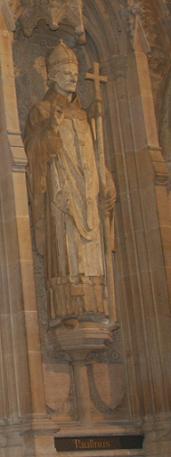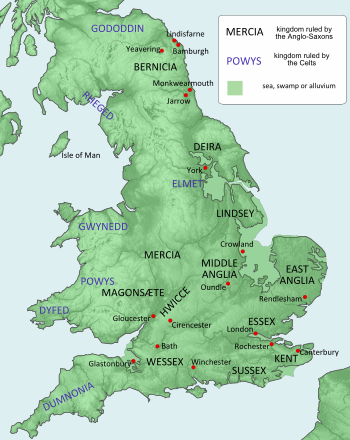Paulinus of York facts for kids
Quick facts for kids Paulinus |
|
|---|---|
| Bishop of York | |

Statue at Rochester Cathedral
|
|
| Appointed | 627 |
| Reign ended | 633 |
| Predecessor | Founder |
| Successor | Chad |
| Orders | |
| Consecration | 21 July 625 by Justus |
| Personal details | |
| Died | 10 October 644 Rochester, Kent |
| Buried | Rochester Cathedral |
| Sainthood | |
| Feast day | 10 October |
Paulinus (who died on October 10, 644) was an important Christian missionary from Rome. He became the first Bishop of York. He was part of a special group of missionaries sent by Pope Gregory I in 601. Their job was to teach Christianity to the Anglo-Saxons in England. Paulinus arrived in England by 604 with the second group of missionaries. We don't know much about what he did for the next 20 years.
After living in Kent for some years, Paulinus became a bishop in 625. He traveled with Æthelburg of Kent, who was the sister of King Eadbald of Kent. Æthelburg was going to Northumbria to marry King Edwin of Northumbria. Paulinus eventually helped King Edwin become a Christian. He also helped many of Edwin's people convert to Christianity and built some churches. One of the people Paulinus baptized was Hilda of Whitby, who later became a saint.
After King Edwin died in 633, Paulinus and Æthelburg had to leave Northumbria. They left behind one of Paulinus's helpers, James the Deacon. Paulinus went back to Kent. There, he became the Bishop of Rochester. He received a special cloth called a pallium from the pope. This cloth showed he was appointed Archbishop of York, but it arrived too late to help him in York. After Paulinus died in 644, he was recognized as a saint. Today, he is honored in the Eastern Orthodox Church, Roman Catholic Church, and Anglican Churches.
Contents
Paulinus's Early Life
Paulinus was a monk from Rome. Pope Gregory I sent him to the Kingdom of Kent in 601. He was part of the second group of missionaries. This group included Mellitus and others. Their goal was to convert the Anglo-Saxons to Christianity. Paulinus was probably born in Italy. The second group of missionaries arrived in Kent by 604. We don't know much about Paulinus's activities until he went to Northumbria.
Paulinus stayed in Kent until 625. On July 21, he was made a bishop by Justus. Justus was the Archbishop of Canterbury. Paulinus then went with Æthelburg to Northumbria. She was going there to marry King Edwin of Northumbria. A rule for their marriage was that Edwin had to let Æthelburg remain Christian. He also had to let her worship as she chose. Bede, a writer from the early 700s, said that Paulinus wanted to convert the people of Northumbria. He also wanted to provide religious services for the new queen.
Some historians have found it difficult to agree on the exact date of Æthelburh's marriage. Letters from the pope to Edwin suggest that King Eadbald had only recently become Christian. This does not quite match Bede's timeline. Historian D. P. Kirby thinks Paulinus and Æthelburh might have gone to Northumbria earlier than 624. He believes Paulinus went north as a priest first, then returned later to become a bishop. Another historian, Henry Mayr-Harting, agrees with this idea. Peter Hunter Blair, another historian, thinks Æthelburh and Edwin married before 625. But he believes she did not go to Northumbria until 625. If Kirby's ideas are correct, Paulinus's consecration date would be July 21, 626.
Bede described Paulinus as "a tall man, a little bent over." He had "black hair and a thin face." His nose was "hooked and thin." Bede said he looked both "respected and impressive."
Paulinus as Bishop of York
Bede wrote that Paulinus told King Edwin that the birth of his daughter, Eanflæd, in 626 was due to Paulinus's prayers. This birth happened around the same time as an attempt to kill the king. Some West Saxons from Wessex tried to assassinate him. Edwin promised to become a Christian if he won a battle against Wessex. He also said his new daughter, Eanflæd, could be baptized.
Edwin did not keep his promise right after winning the battle. He only converted after Paulinus told him about a dream. Edwin had this dream before he became king. He was in exile at the court of King Rædwald of East Anglia at the time. In the dream, a stranger told Edwin he would gain power. The stranger said this would happen when someone laid a hand on his head. As Paulinus told Edwin about the dream, he laid his hand on the king's head. This was the proof Edwin needed. A story from the late 600s says Paulinus was the stranger in the dream. If true, Paulinus might have spent time at Rædwald's court. However, Bede does not mention such a visit.
It is unlikely that only dreams and Paulinus's words made Edwin convert. The nobles in Northumbria seemed willing to accept Christianity. The king also received letters from Pope Boniface V urging him to convert. Finally convinced, Edwin and many of his followers were baptized in York in 627. One story says that Paulinus stayed with Edwin and Æthelburg at their palace in Yeavering. There, he spent 36 days baptizing new converts. Paulinus also worked as a missionary in Lindsey. His missionary work helps us understand the limits of Edwin's royal power.
Pope Gregory had planned for York to be England's second main church center. So, Paulinus built his church there. It was made of stone, but no trace of it has been found today. Paulinus also built several churches on royal lands. His church in Lincoln is believed to be the earliest part of the church of St Paul in the Bail.
Among those baptized by Paulinus were Hilda and Eanflæd. Hilda later became the first abbess of Whitby Abbey. Eanflæd, Edwin's daughter, became Hilda's successor. Paulinus was the only Roman bishop in England at the time. He also made Honorius the Archbishop of Canterbury. This happened after Justus died, sometime between 628 and 631.
Paulinus as Bishop of Rochester
King Edwin was defeated by an alliance of Welsh and Mercian Angles. He was killed at the Battle of Hatfield Chase. This battle is traditionally said to have happened on October 12, 633. There is some debate about the date of the battle. Pope Honorius I wrote letters in June 634 to Paulinus and Archbishop Honorius. He said he was sending a pallium to each of them. A pallium is a symbol of an archbishop's authority. The pope's letter shows no sign that he knew about Edwin's death. This was almost nine months after the battle's supposed date. Historian D. P. Kirby believes this lack of knowledge means the battle likely happened in 634.
Edwin's defeat and death caused his kingdom to split into at least two parts. It also led to a big decline in Christianity in Northumbria. Edwin's immediate successors went back to paganism. His widowed queen, Æthelburg, fled to her brother Eadbald's kingdom of Kent. Paulinus went with her. Edwin and Æthelburg's son, daughter, and grandson also went. The two boys went to Europe for safety, to the court of King Dagobert I. Æthelburg, Eanflæd, and Paulinus stayed in Kent. There, Paulinus was offered the position of bishop of Rochester. He held this position until he died. The pallium did not reach Paulinus until after he had left York. So, it was not useful to him for his role in York. Paulinus's helper, James the Deacon, stayed in the north. He worked hard to rebuild the Roman Christian mission there.
Death and Recognition
Paulinus died on October 10, 644, in Rochester. He was buried in the sacristy of the church there. His successor at Rochester was Ithamar. Ithamar was the first Englishman to become a bishop in a place where Gregorian missionaries had worked. After Paulinus's death, he was honored as a saint. His feast day is on October 10. When a new church was built in Rochester in the 1080s, his relics (remains) were moved to a new shrine. There were also shrines to Paulinus in Canterbury. At least five churches were dedicated to him. Rochester had some of Paulinus's relics. However, the honoring of him as a saint there seems to have grown after the Norman Conquest. He is considered a saint by the Roman Catholic Church, the Anglican Communion, and the Eastern Orthodox Church.
It is hard to know how successful Paulinus's missionary work was. Bede suggests that the mission in Northumbria was very successful. But there is not much other evidence to support this. It is more likely that Paulinus's efforts there were not very effective. Although Osric, one of Edwin's successors, was converted by Paulinus, he returned to paganism after Edwin died. Hilda, however, remained a Christian. She eventually became the abbess of the important Whitby Abbey. Northumbria mostly converted to Christianity because of Irish missionaries. These missionaries were brought into the region by Edwin's later successor, Oswald.
See also
 In Spanish: Paulino de York para niños
In Spanish: Paulino de York para niños


